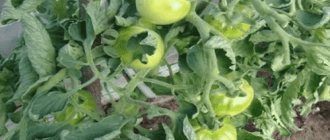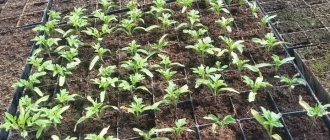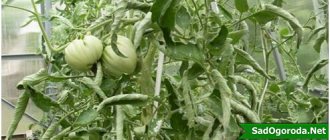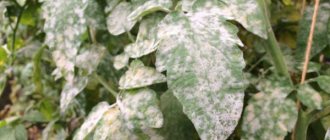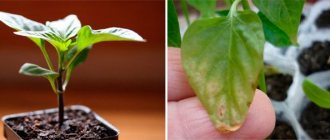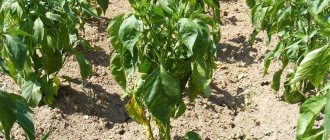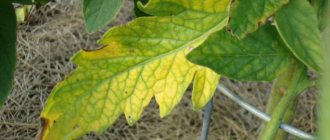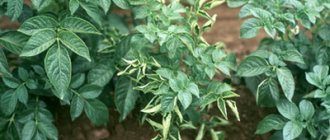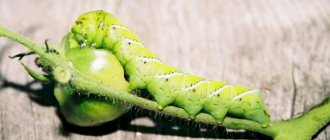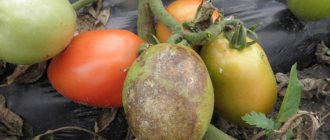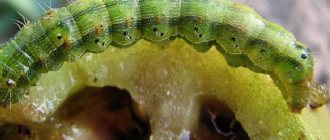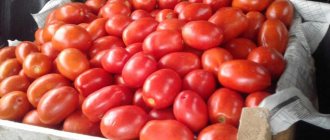Open ground problems
The leaves of tomatoes growing outside may turn black due to frost or disease.
In the first case, it is enough for the bushes to remain without shelter at temperatures below -3°C. This usually happens when it gets cold at night. The leaves droop, and in the morning under the sun's rays they turn completely black.
Most of the tomato diseases that accompany this symptom often affect plantings in open ground. Infection in a greenhouse is not impossible, but less likely.
To determine the pathogen, pay attention to the nature of blackening and other changes in the appearance of the bushes.
Leaves turn black and curl inwards
The tomatoes are probably affected by late blight. This is a common disease of nightshade crops, most dangerous in regions with a temperate climate, that is, the entire central zone of Russia falls into the risk zone.
The disease is caused by the late blight fungus. For its spores to germinate and penetrate plant tissue, a humidity level of at least 75% and a moderate temperature are required - already at +26°C the development of the population stops.
The most dangerous weather is when cool nights (+12...+15°) alternate with warm (+20...+24°), but cloudy days.
In protected soil conditions, the fungus rarely appears and, as a rule, only in film greenhouses.
The lower leaves are the first to suffer - they become covered with dark spots, the largest number of which are concentrated in the upper part or along the edges of the plate.
In damp summers, a light coating forms on the back of the leaves, outlining the boundaries of the spots. Later, the damaged tissues dry out.
The disease quickly spreads throughout the bush, reaching the top. Spots appear on both stems and stalks.
If the plant has already set fruit, brown areas will form near the stem, which will grow until they cover the entire tomato.
With sufficient humidity, these damaged areas are covered with a light coating of spores.
The plumping fruits retain a healthy appearance, while tomatoes suffer as they rapidly gain weight. Affected plants die quickly.
PHYTOPHORA ON TOMATOES - ENEMY No. 1. [An effective way to fight.]
Yellow-black spots on the leaves of mature tomato seedlings
The causative agent is the bacterium Xanthomonas vesicatoria, which is also dangerous for peppers.
The later the seedlings are planted, the higher the risk of infection with black bacterial spot.
- firstly, for development the pathogen requires a temperature within +25...+30°C;
- secondly, it is young plants that are least resistant to it.
Black spots in this case are specks up to 3 mm in diameter, surrounded by a narrow yellow border.
The dark areas have a watery texture; on young leaves they dry out and collapse, forming holes.
The spots appear between the veins, but as their number increases, the dark areas merge and can stain the vessels. Severely damaged leaves turn yellow and fall off. The seedling bushes have a depressed appearance.
Speckles also appear on stems and petioles, and depressed dark areas appear on green fruits that increase in size.
The tissue around the formation becomes watery, rots and cracks, and scabs appear.
The disease can affect tomatoes at any stage of development; it is least dangerous during the period of filling tomatoes, and most destructive for the bush at an early stage.
However, in the phase of active fruit growth, the disease can ruin most of the harvest, although the life of the plant is not threatened.
Round black spots on leaves
Concentric spots on the petioles and leaves may indicate tomato spotted wilt. This disease is usually accompanied by bronze spots on the leaves.
But besides the classical form of the flow, there is another one - necrotic bronzeness, in which black spots appear.
Not all of them will have a round shape, but the symptom is characteristic. It will be possible to more accurately determine the disease by the fruits - black-brown rings form on them.
The lesion penetrates deeply into the plant tissue, and the significantly damaged leaf dries out. Over time, the top of the bush dies off, but the tomato does not die. The yield is significantly reduced and the quality of the fruit suffers.
Differences in the course of the disease are due to the existence of several strains of the tomato spotted wilt virus that causes it.
The pathogen can infect eggplants, peppers and tobacco. If petunia grows next to a garden bed, necrotic spots on its leaves will accurately confirm the presence of the virus.
Symptoms usually develop after an attack by thrips, which serves as a vector for the pathogen.
Dark halo around a white spot
The infection is caused by the fungus Septoria lycopersici. The colony develops most intensively on tomatoes, but can also settle on potatoes and eggplants.
To develop, the fungus requires a temperature of +15 to +27°C and air humidity of at least 77%.
The disease often affects pears and moves from them to tomato beds, so it is better to place the planting away from the tree.
The spots are no more than 3 mm in size and can densely cover leaves, stems and fruits. The sign is characteristic of the second stage of septoria.
The first changes are difficult to notice; at first, watery spots that have no color appear. On young plants, which are more resistant to the disease, there are very few of them.
But very quickly the spots acquire a white color and a dark brown, and a little later - a dark brown halo. In the center of the white area you can see small black dots - these are pycnidia of the fungus.
Unaffected leaf tissues turn yellow and dry out. The leaves of the lower tier are the first to suffer; the top usually does not change its appearance.
The disease is most harmful for young tomatoes; in this case, yield losses can reach 40%.
The loss of a large proportion of the cover forces the plant to expend energy on growing new leaves with damage to the fruit. The bush produces small tomatoes with limp pulp.
The leaves turn black and dry in the greenhouse
Almost any tomato disease can appear in a greenhouse. Infection occurs through seeds or added soil; spores and bacteria are brought on clothes and tools by the gardener himself.
But there are also greenhouse diseases that rarely or very locally develop in open ground conditions. Some of them can also cause leaves to turn black.
The tissues around the edges of the leaves darken and dry out.
Round spots of dark brown color, concentrated along the edges of the leaf blade, are a sign of Alternaria blight. Another name for the disease is macrosporiosis. The disease is caused by the fungus Alternaria nightshade.
Alternaria blight affects plants at any age and develops most intensively in a greenhouse. All nightshades growing next to tomatoes are under threat.
Sometimes the damaged areas are surrounded by a yellow border. Gradually they grow, reaching a diameter of up to 1.5 cm, and in conditions of high humidity they become covered with a dense black coating.
The spots first appear on the lower leaves, but spread to all above-ground organs of the plant, excluding flower petals.
The spots on the fruit are black, round, dry, increasing in size and covering most of the surface. Affected leaves dry out.
Black areas on stems and fruits are cracking. As a result of the disease, the growth of bushes slows down, the quality of fruits deteriorates and their number decreases. The stem may break, leading to the death of the tomato.
Cladosporiosis (macrosporiosis) of tomatoes
Entire tomato branches turn black and dry out
This can happen due to end-to-end damage to the stems by gray rot. But first, brown, weeping spots of irregular shape appear on the leaves and stems; at high air humidity, a gray-white coating forms on them.
Later, the damaged areas dry out and become covered with a dark gray layer of fungal spores.
The disease is caused by the fungus Botrytis cinerea Fr. Conidia can penetrate the plant only through wounds, so symptoms often appear after pinching.
The bites of pests can also become an entry point for the fungus. Most often, plants in film greenhouses get sick, especially when planted densely, and less often in glass and polycarbonate greenhouses.
In open ground, gray rot rarely affects tomatoes.
The spots ring the stems, flowering tomatoes develop necrosis on the petals, and the flowers fade and fall off.
Brown wet spots covered with a velvety coating grow on the fruits. Plants die quickly, young ones are especially vulnerable.
Gray rot on tomatoes
Dark spots on the back of a tomato leaf
The sign appears at the sporulation stage of the fungus Cladosporium brown (Fulvia brown-yellow). At the beginning of the infection, the leaves become covered with yellow or light green round spots.
On the other side of the plate, the spot spots are covered with a light gray coating, which later acquires a brown or brownish-green color. Necrosis develops in damaged areas and leaves fall off.
For infection to develop, high air humidity is required - about 90%. The fungus is undemanding to temperature; it develops at +10…+32°С, but the best conditions for it are +22…+25°С.
Signs of cladosporiosis or brown spot begin to appear from the bottom of the bush; the disease rarely affects the upper tier, only in the case of intensive development of the infection.
Black depressed spots, covered with a black velvety coating, form on the fruits. The appearance of other parts of the plant most often remains unchanged.
The pathogen is dangerous only for tomatoes and usually affects in the greenhouse.
Other reasons
Blackening of tomato leaves sometimes indicates a deficiency of certain elements. In all these cases, the symptom is secondary; other changes in the appearance of the bush appear earlier.
The leaves darken in different ways, the damage occurs either from the top or from the bottom of the bush, the edges may curl downwards.
The bushes turn black on top
Blackening of the growing point in tomatoes is a sign of severe boron deficiency. With a slight deficiency, the upper leaves on the bush curl and lighten, and the plant produces few flowers and ovaries.
In case of advanced boron starvation, large veins on the leaves become black or brown in color, and the plate becomes brittle.
The upper part of the stem darkens, below this area stepsons actively grow, and the bush branches heavily.
Eventually, the top turns black and dies, and over time the upper parts of the side shoots dry out.
During the flowering period, a lack of boron causes flowers and ovaries to fall off. At the fruiting stage, dark spots of necrosis appear on tomatoes.
The trace element is involved in the processes of photosynthesis, cell division and development, metabolism and delivery of sugars to fruits and growing parts of the bush.
Boron is necessary for the development of a strong root system and the growth of the above-ground part of the bush. The substance stimulates the formation of flowers and ovaries, the accumulation of sugars in fruits, increases resistance to fungal diseases and prevents fruit rotting in case of high humidity.
Microelement deficiency often develops in acidic or alkaline soils, sandy, calcareous soils saturated with organic matter and calcium carbonate.
Boron starvation can occur due to lack or excess of irrigation, overfeeding with nitrogen or potassium.
Lack of Boron in tomatoes!
Seedling leaves turn black
If the leaves of tomatoes acquire a dark purple color, and then begin to turn black and curl, it means that the plants do not have enough phosphorus.
The anthocyanin tint first appears on the leaves and stem at the bottom of the bush, gradually spreading upward.
But rarely does the plant turn completely purple; more often the top remains green. The tomato stops growing, bears fruit poorly and loses its immunity.
Phosphorus is necessary for flowering and fruit ripening; it ensures the development of a strong root system and, indirectly, affects the growth of green mass, since its deficiency interferes with the absorption of nitrogen.
Even if the soil is rich in this macronutrient, tomato roots cannot consume phosphorus due to too acidic or alkaline soils, or when the temperature drops below +15°C.
Element deficiency most often appears at the early stage of tomato development, but can also occur in adult plants.
Signs of phosphorus deficiency in tomatoes!
Tomato tops and leaves turn black
A brown spot forms at the top of the fruit, which becomes black, depressed and wrinkled as the tomato grows. The lesion may cover half of the fetus.
This is blossom end rot, a non-infectious disease caused by calcium deficiency.
Other manifestations of element deficiency are darkening of old leaves, chlorosis and curling of the edges downward in young leaves, growing necrotic spots from the edge of the leaf, and death of the top of the bush. Damaged tissue becomes an entry point for fungi.
Calcium is involved in the growth of roots and the green part of the bush, activates enzymes and stimulates metabolic processes.
Provides resistance to diseases and temperature changes, shelf life of fruits, and their taste and size also depend on it.
Deficiency is promoted by acidic and light peat soils, saline soils, and excess nutrition of magnesium or nitrogen.
Symptoms of blossom end rot due to element deficiency do not always develop; tomato varieties with elongated fruits are most prone to this.
The tomatoes are turning black on the bottom. TOP ROT - the result of my mistake!
Why do tomatoes turn black when dried?
Blackening of tomatoes during drying is a common phenomenon; it is usually associated with violations of fruit processing technology. These reasons are the most common:
- the temperature is not high enough (drying should be done at a temperature greater than 45°C);
- long periods of exposure to direct sunlight (over a whole day of exposure to the sun, the crust of tomatoes simply burns);
- poor-quality cutting of fruits - ideally, the pieces should not be thick, only then will it be possible to preserve their natural color;
- drying in a gas oven.
If the black crust does not cause a deterioration in taste, then dried tomatoes can be stored all winter and served with any dish.
How to treat tomatoes against fungus
For the treatment of fungal diseases, treatment with drugs of the fungicide class is indicated.
Chemical agents are the most effective, but they cannot be used during the flowering period and later than 3-4 weeks before harvesting the fruits (the period varies for different drugs, it is indicated in the instructions).
It is unreasonable to completely abandon “chemistry” - any fungi are very difficult to remove, most pathogens overwinter safely and appear on plantings next year.
It is recommended to repeat treatment with fungicides after 10-15 days, even if there are no signs of disease. Some drugs require more treatments.
If the fight against the fungus has been going on for several years, it is advisable to use products with different active ingredients, since the pathogen quickly develops resistance to the poison.
If a lesion is detected during the flowering phase or shortly before harvest, when chemicals are contraindicated, spraying with biofungicides is resorted to.
Such products contain microorganisms that are safe for plants and feed on fungal spores and pathogenic bacteria.
Biofungicides contain no toxic substances and are safe for humans, animals and bees. However, you must prepare and use a solution with such a product strictly according to the instructions - bacteria die at the wrong temperature or in the light.
There are also folk recipes; they are more suitable for the prevention and protection of neighboring plantings that are not affected by the disease.
Such tinctures and decoctions do not penetrate the plant tissue, creating a protective film on the surface, so spraying must be repeated after rain.
Late blight
The disease can quickly spread throughout a tomato planting and spread to a bed of potatoes or eggplants, so when the first symptoms appear, it is important to localize the foci of infection.
Remove all leaves and branches affected by the fungus from the bush. The cuttings must be burned off-site.
You can’t put it in compost - the fungus will successfully overwinter and appear again next year. Disinfect the pruning tool with a dark solution of potassium permanganate.
After this, spray the bushes with fungicides. Choose drugs of combined action - contact and systemic, which not only destroy the pathogen on the surface of plants, but also penetrate deep into the tissues.
Drugs from the strobilurin group are indicated against late blight; active ingredients of this type contain:
- Pharmacist.
- Strobe.
- Profit Gold.
- Thanos.
- Famox.
- Healer, etc.
Among biofungicides, Fitosporin-M is the most effective. Alirin-B, Gamair, Trichoderma Veride 471 are also suitable.
Experienced gardeners recommend garlic tincture:
- chop 200 g of garlic cloves, best squeezed through a press;
- pour 250 ml of warm water;
- stand for 24 hours in a dark place;
- strain and dilute with a bucket of water;
- dissolve 1 g of potassium permanganate in the infusion.
The milk-iodine solution has proven itself well in the treatment of fungal diseases. It is better to take sour milk for it, ideally whey.
Solution recipe:
- dilute 1 liter of dairy product with a bucket of water;
- add 30 drops of iodine;
- mix and use immediately for spraying (do not store).
HOW I GOT RID OF PHYTOPHORA IN TOMATOES ONCE AND FOR ALL!
Septoria
First, remove all affected plant parts. Dark spots on the leaves in the case of septoria appear already at a late stage of the disease, so folk remedies are useless, it is necessary to use “chemistry”.
Fundazol, Ridomil Gold, Acrobat MC, Thanos, Revus are suitable for this.
Use the last two products for treatments in rainy and cold summers; unlike others, they work in any weather.
Of the biological drugs against septoria, Sporobacterin works well.
For prevention and support, additionally spray the bushes with a weak solution of potassium permanganate (1 g of potassium permanganate per 10 liters of water).
Alternaria blight
The same chemicals that are indicated for late blight, with active ingredients of the strobilurin group, are suitable for the treatment of macrosporiosis.
In addition to them, drugs based on triazoles are effective, for example, Raek, Racurs, Skor, as well as copper-containing products.
The last group includes copper sulfate, Bordeaux mixture, and Burgundy liquid.
These drugs can also be used in the treatment of late blight and septoria, but Alternaria and Cladosporiosis are considered clear indications for their use. The treatment is carried out after the formation of ovaries; it is not used before flowering.
In rainy summers in open ground, spraying should be repeated every 10-12 days, the last treatment no later than 8 days before harvest.
Fruits from treated bushes should be thoroughly washed before eating.
The easiest way is to prepare a solution of copper sulfate, but for tomatoes, Bordeaux and Burgundy liquids, products with lower acidity, are more suitable.
In Bordeaux mixture, alkalization occurs due to lime, which also ensures the “tenacity” of the solution, extending the protection period to up to a month.
The vitriol solution is valid for 2 weeks. But lime blocks the leaves’ access to oxygen, so Burgundy liquid, in which soda acts as an alkali, is a more gentle remedy.
Rules for preparing a solution of copper sulfate:
- Mix the product in plastic or glass containers; iron buckets should not be used. This applies to all copper-containing products.
- To prepare 5 buckets of solution, dilute 100 g of copper sulfate in 1 liter of warm water (40-50 degrees). When the crystals dissolve, dilute the concentrate with the required volume of water.
- To treat tomato bushes, the solution concentration should be 0.2%. That is, 1 bucket will require 20 g of the substance.
- If a sprayer is used for spraying, the product is filtered to prevent any remaining crystals from clogging the nozzle.
In Bordeaux mixture, the concentration of copper sulfate should be 1%.
For 1 bucket of product:
- Pour 100 g of the substance into 0.5 liters of warm water in a plastic or glass container. Stir.
- After the crystals have dissolved, add water, increasing the volume of the solution to 5 liters.
- In another container (not metal), dilute 200 g of lime with cold water.
- Mix the lime solution well and add water to make 5 liters of liquid. Mix thoroughly again.
- Pour the vitriol solution in a thin stream into the lime solution. You can only mix this way; you cannot pour lime into vitriol.
If you place a new iron nail in Bordeaux mixture and it does not become covered with rust in 2-4 minutes, then you can safely spray tomato bushes with the product. This method is used to test acidity.
To prepare 5 liters of 1% Burgundy liquid:
- Dissolve 50 g of copper sulfate in 100 ml of warm water.
- Separately, dilute 25 g of soda with water.
- Drain both liquids into one bucket.
- Add water to make 5 liters of product.
- Dissolve 25 g of laundry soap shavings in it to increase the “stickiness” of the liquid.
Use any of these three solutions immediately after preparation.
Alirin-B, Gamair, Fitosporin-M are suitable as biofungicides against Alternaria.
In advanced cases, without regret, remove the most affected bushes from the garden bed and burn it away from it to stop the spread of infection.
Cladosporiosis
Before processing, remove diseased leaves. When a leaf is torn off, light conidia will disperse into the air, infecting other plants, so wrap each leaf in a plastic bag and carefully cut with a knife.
For cladosporiosis, bushes are also sprayed with copper-containing agents, and if they do not help, “heavy artillery” is used - chemical fungicides. Suitable for Polyram, Polychom, HOM, Bravo, Tsineb. The most effective biological products in this case are Pseudobacterin-2 and Fitosporin-M.
In addition, try to reduce the humidity in the greenhouse to at least 65%, and keep the temperature within +25...+30°C. Under such conditions, the fungal colony will develop more slowly.
Stop watering for a while and weed the planting - the pathogen can develop on weeds. Burn the weeds along with the cut leaves.
Treatment with iodine solution will be useful:
- Dissolve 40 drops of iodine in 10 liters of water and mix.
- Spray the bushes and spill the soil under the tomatoes.
- The soil should be wet to a depth of 10 cm.
Ash solution is also used:
- Boil 300 g of ash in 3 liters of water for half an hour.
- Dilute the solution in 7 liters of water and leave for 3 days.
- Spray and water the bushes with the prepared product once a week.
Add a little laundry soap to the ash or iodine solution for spraying (not for watering!) so that it sticks better to the leaves and stems.
Gray rot
To treat gray rot, cut off the affected areas of plants with a sharp knife and burn them outside the greenhouse away from the beds. The procedure should be carried out in dry and sunny weather.
After pruning, treat the plantings with chemicals Bayleton, Previkur, Skor, Topsin M, Acrobat MC, Agat 25K, Maxim, Euparena multi, Oxychom, Ordan, Fundazol.
In case of minor damage, spraying with Bordeaux mixture or Profit, Kuproskat, Roval, Champion, Ditan M-45 will be sufficient. For biological protection, use Gamair.
Coat the spots on the stems with a paste of any preparation suitable for spraying. To do this, dissolve 20-50 g of the substance in a bucket of water (the volume should correspond to the dosage of the product per 10 liters of water). Add crushed chalk in portions until the mixture becomes a paste.
Spray healthy tomatoes with Trichodermin or Fitosporin-M. Apply the same solutions to all plant wounds that form during pinching; the fungus penetrates only through damaged tissue.
Three folk recipes against gray rot:
- dissolve 100 g of baking soda in 10 liters of water;
- Grind 100 g of laundry soap into shavings and dissolve in a bucket of water;
- prepare a 1% solution of boric acid (10 g of substance per 1 l).
Any of these products should be sprayed on all bushes, including healthy plants.
Prevention methods
To prevent blackening of tomatoes even before planting, you need to take the following measures:
- Choose the right place to plant tomatoes: new bushes cannot be planted where potatoes, peppers or physalis used to grow. If the seedlings are placed in the same place in the garden where tomatoes used to grow, then the soil must be completely renewed and replaced (in order to avoid the proliferation of last year’s spores).
- Check the irrigation of future beds: rainwater should not stagnate for a long time.
- Attach a trellis to each bush and tie up new shoots in time.
During the ripening of the crop, it is also necessary for prevention:
- Ventilate the greenhouse with fresh air from the street at least once a day.
- Apply balanced fertilizers without excess nitrogen.
- Protect from sudden temperature changes (cover with polyethylene in a timely manner).
- Water the bush only at the root, avoiding direct contact of water with the leaves.
How to treat other tomato diseases
Unlike fungi, viruses are resistant to all existing drugs.
It is recommended to dig up and burn affected specimens to stop the spread of the disease.
In the case of tomato spotted wilt, the bush can be left, especially if it is only slightly damaged, since this virus does not spread through the air and only enters through wounds.
But when pests, especially thrips, appear, the risks of infecting other plants become high.
In other cases, there is still a chance to restore the health of tomatoes with blackened leaves.
Black bacterial spot
At the initial stage of the lesion, biological products such as Fitolavin, Planzir, Fitosporin-M, Baktofit, Gamair are quite effective. If the disease is actively spreading through the bushes, copper-containing products are used.
You can spray with Bordeaux mixture, but in this case a solution of copper oxychloride is preferable.
To prepare it, dilute 40 g of the substance in 10 liters of water. This volume is enough to spray 1 hectare of planting. Repeat after 14 days. A total of 3-5 treatments are allowed per season, the last of which must be carried out no later than 20 days before harvesting the fruits.
Like other products in this group, copper oxychloride cannot be used during flowering.
Copper-based chemicals (Alpha-Copper, Kuproskat) or mancozeb (Ditan M-45, Pencozeb) are also suitable for combating black spot.
Frost
When the temperature drops to -3°C, irreversible processes begin in the body of tomatoes. But sometimes it is possible to revive them in this case too.
A strong remedy that often helps even when the roots freeze is a solution of cow manure or bird droppings.
Dilute cow manure with water in a ratio of 1 to 10, the concentration of the solution with bird droppings should be 2 times less - 1 to 20.
Use only rotted manure or old droppings, otherwise you can burn the roots of the tomatoes. Water the prepared solution 1 liter per bush.
If there is no cow manure, water the tomatoes with humates. Dissolve a tablespoon of Gumat-80, Gumat Universal or similar preparations in a bucket of water. Before this fertilizing, water the plants generously.
Trim the top of the bush to healthy tissue only in case of minor damage, after which the tomatoes are fed with urea or ammonium nitrate.
These are nitrogen fertilizers that will help restore foliage cover. In both cases, 20 g of the substance is required per bucket of water.
For heavily damaged bushes, pruning will become unbearably stressful. If the plants survive, the blackened top will gradually dry out on its own.
Regardless of the degree of damage, spray the bushes with immune stimulants (Epin-extra or Stimul). For the next week after hypothermia, keep them under a film cover.
If frost is detected at night, there is a chance to minimize the consequences. Spray the tomatoes with water and shade them from the rising sun. The slower the bushes thaw, the less they will suffer.
Element deficiency
If there is a deficiency of any substance, feed by foliar feeding. Tomatoes absorb nutrition faster through their leaves than through their roots.
If the plants do not have enough phosphorus, dissolve 15 g of superphosphate in a liter of boiling water and leave to infuse for half a day.
Add 300 ml of the prepared infusion to each bucket of water for spraying and mix.
In case of boron starvation, treat the bushes with a solution of boric acid. In this case, the dose is increased to 1 g of product per 1 liter of water. For routine feeding, make a 0.05% solution.
Dilute the powder with hot water (at least 55°C), otherwise some of the crystals will not dissolve, which can result in leaf burns.
Before spraying, wait until the solution cools to room temperature. You can dilute the powder with a small volume of hot water, and then pour the concentrate into cold water, this will save time.
Replenish calcium deficiency with calcium nitrate. The recommended dosage is 20 g of the substance per 10 liters of water.
Repeat spraying once a week until you are sure that blossom end rot has stopped affecting new fruits.
Tomatoes with spots cannot be revived; pick them from the bush and burn them - fungus may already live in them.
To prevent fungal diseases, it makes sense to treat the bushes with an ash solution (as against cladosporiosis), adding 15 g of soda per bucket.
Frosts have arrived
A frozen tomato should not be thrown away immediately; if the veins inside are solid, the plants will survive.
The cause of black leaves on young tomato seedlings can be late spring frosts . Tomatoes are a heat-loving garden crop. Slight negative temperatures lead to freezing of the above-ground parts of the plant. Most often the tops are damaged. They wither, turn black, and subsequently die.
Frostbitten bushes can be revived if the frost has not damaged the tomato root system.
Procedure:
- Trim off all affected shoots and stems.
- Treat the sections with an unsaturated solution of potassium permanganate.
- Pour warm water into the hole and add fertilizer (urea, slurry, complex fertilizers).
- Protect damaged seedlings from the sun for 1-1.5 weeks.
- Spray the plant with growth stimulants. The drugs Epin and Zircon (a teaspoon in a bucket of water) are effective.
The reanimated plants will begin to bloom and bear fruit, lagging behind their peers undamaged by frost by 1.5-2 weeks.
If the weather forecast is disappointing, you should wrap street and greenhouse seedlings in advance with several layers of covering material or delay planting.
Covering tomatoes with cardboard boxes before spring frosts.
